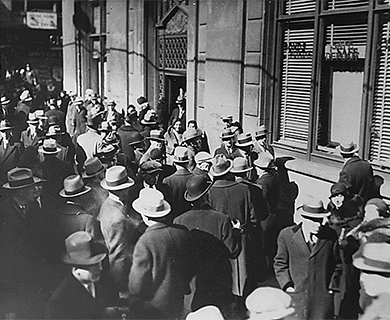| << Chapter < Page | Chapter >> Page > |

The risk of bank runs created instability in the banking system. Even a rumor that a bank might experience negative net worth could trigger a bank run and, in a bank run, even healthy banks could be destroyed. Because a bank loans out most of the money it receives, and because it keeps only limited reserves on hand, a bank run of any size would quickly drain any of the bank’s available cash. When the bank had no cash remaining, it only intensified the fears of remaining depositors that they could lose their money. Moreover, a bank run at one bank often triggered a chain reaction of runs on other banks. In the late nineteenth and early twentieth century, bank runs were typically not the original cause of a recession—but they could make a recession much worse.
To protect against bank runs, Congress has put two strategies into place: deposit insurance and the lender of last resort. Deposit insurance is an insurance system that makes sure depositors in a bank do not lose their money, even if the bank goes bankrupt. About 70 countries around the world, including all of the major economies, have deposit insurance programs. In the United States, the Federal Deposit Insurance Corporation (FDIC) is responsible for deposit insurance. Banks pay an insurance premium to the FDIC. The insurance premium is based on the bank’s level of deposits, and then adjusted according to the riskiness of a bank’s financial situation. In 2009, for example, a fairly safe bank with a high net worth might have paid 10–20 cents in insurance premiums for every $100 in bank deposits, while a risky bank with very low net worth might have paid 50–60 cents for every $100 in bank deposits.
Bank examiners from the FDIC evaluate the balance sheets of banks, looking at the value of assets and liabilities, to determine the level of riskiness. The FDIC provides deposit insurance for about 6,509 banks (as of the end of 2014). Even if a bank fails, the government guarantees that depositors will receive up to $250,000 of their money in each account, which is enough for almost all individuals, although not sufficient for many businesses. Since the United States enacted deposit insurance in the 1930s, no one has lost any of their insured deposits. Bank runs no longer happen at insured banks.
The problem with bank runs is not that insolvent banks will fail; they are, after all, bankrupt and need to be shut down. The problem is that bank runs can cause solvent banks to fail and spread to the rest of the financial system. To prevent this, the Fed stands ready to lend to banks and other financial institutions when they cannot obtain funds from anywhere else. This is known as the lender of last resort role. For banks, the central bank acting as a lender of last resort helps to reinforce the effect of deposit insurance and to reassure bank customers that they will not lose their money.
The lender of last resort task can come up in other financial crises, as well. During the panic of the stock market crash in 1987, when the value of U.S. stocks fell by 25% in a single day, the Federal Reserve made a number of short-term emergency loans so that the financial system could keep functioning. During the recession of 2008–2009, the “quantitative easing” policies (discussed below) of the Federal Reserve can be interpreted as a willingness to make short-term credit available as needed in a time when the banking and financial system was under stress.
A bank run occurs when there are rumors (possibly true, possibly false) that a bank is at financial risk of having negative net worth. As a result, depositors rush to the bank to withdraw their money and put it someplace safer. Even false rumors, if they cause a bank run, can force a healthy bank to lose its deposits and be forced to close. Deposit insurance guarantees bank depositors that, even if the bank has negative net worth, their deposits will be protected. In the United States, the Federal Deposit Insurance Corporation (FDIC) collects deposit insurance premiums from banks and guarantees bank deposits up to $250,000. Bank supervision involves inspecting the balance sheets of banks to make sure that they have positive net worth and that their assets are not too risky. In the United States, the Office of the Comptroller of the Currency (OCC) is responsible for supervising banks and inspecting savings and loans and the National Credit Union Administration (NCUA) is responsible for inspecting credit unions. The FDIC and the Federal Reserve also play a role in bank supervision.
When a central bank acts as a lender of last resort, it makes short-term loans available in situations of severe financial panic or stress. The failure of a single bank can be treated like any other business failure. Yet if many banks fail, it can reduce aggregate demand in a way that can bring on or deepen a recession. The combination of deposit insurance, bank supervision, and lender of last resort policies help to prevent weaknesses in the banking system from causing recessions.
U.S. Department of the Treasury. “Office of the Comptroller of the Currency.” Accessed November 2013. http://www.occ.gov/.
National Credit Union Administration. “About NCUA.” Accessed November 2013. http://www.ncua.gov/about/Pages/default.aspx.

Notification Switch
Would you like to follow the 'Principles of economics' conversation and receive update notifications?